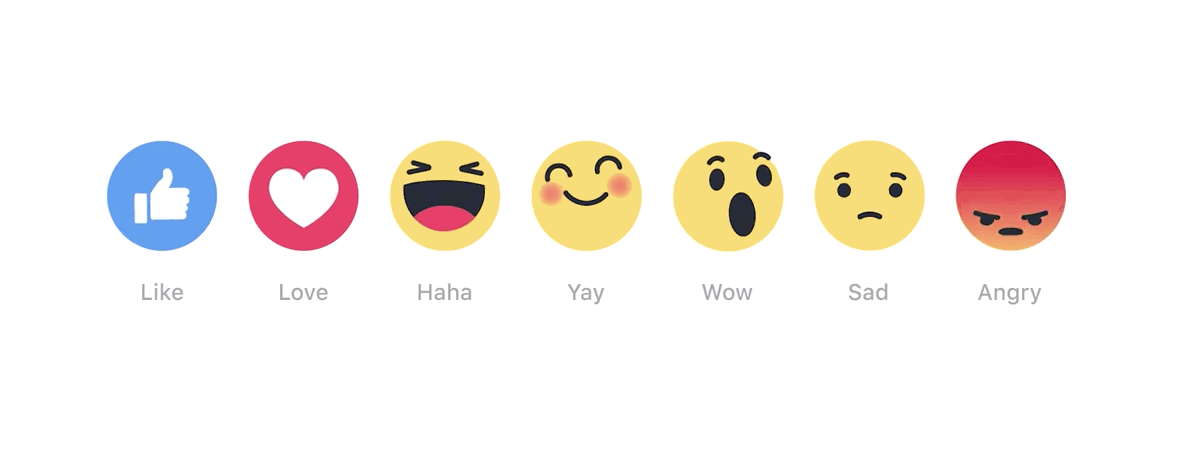They’re heeere:
 Well, all except ‘Yay’ , of course – ‘Yay’ didn’t make it through the first rounds of live testing – but after months of speculation, discussion and refinement, Facebook’s new ‘other than Like’ options, ‘Reactions’ are now available to all users. You would have seen then this morning when you logged onto Facebook – just below each post, you can see little faces like these peeking out.
Well, all except ‘Yay’ , of course – ‘Yay’ didn’t make it through the first rounds of live testing – but after months of speculation, discussion and refinement, Facebook’s new ‘other than Like’ options, ‘Reactions’ are now available to all users. You would have seen then this morning when you logged onto Facebook – just below each post, you can see little faces like these peeking out.
.jpg) Obviously, the ‘Like’ is still there – this was one of the key innovation notes of Reactions, that they not be too intrusive or alter the user experience too much. As such, Reactions only appear when you hover over or click on ‘Like’ – on desktop it’s when you hover the mouse pointer over the ‘Like’ icon, on mobile you need to click and slide across to choose your preferred response.
Obviously, the ‘Like’ is still there – this was one of the key innovation notes of Reactions, that they not be too intrusive or alter the user experience too much. As such, Reactions only appear when you hover over or click on ‘Like’ – on desktop it’s when you hover the mouse pointer over the ‘Like’ icon, on mobile you need to click and slide across to choose your preferred response.
 And while we’ve all known Reactions were coming for some time, it’s still exciting to see them actually there, actually smiling and frowning back as you scroll through, and to start getting some insight into how people actually use this new tool to respond to Facebook content.
And while we’ve all known Reactions were coming for some time, it’s still exciting to see them actually there, actually smiling and frowning back as you scroll through, and to start getting some insight into how people actually use this new tool to respond to Facebook content.
So far, according to Zuck himself, the ‘Love’ emoji has been the most utilized.
Facebook’s gone through a lot of testing to ensure Reactions best represent what people want to see on the platform, assessing how often people respond to posts with one-word answers (like ‘LOL’ and ‘Love’) as well as how people are using emoji in their on-platform interactions. Facebook’s also gone through a slow roll-out process for Reactions, flagging their pending arrival back in October when The Social Network first started testing the new option with users in Spain and Ireland. That gradual process was deliberate, and it’s likely helped take some of the initial backlash out of the worldwide implementation of the tool, as everyone’s had a chance to think about it and accept the new option ahead of its full release.
But however you look at it, Facebook’s Reactions are going to change the way we approach and utilize Facebook data and insights. More response options, used by a larger number of people, will mean a whole new dataset to assess and work with to improve and refine our outreach messaging on the platform.
So what do you need to know about Reactions and how they’ll change your approach to Facebook marketing? The key details are these:
WHY REACTIONS?
Ever since the inception of the ‘Like’ button on Facebook back in 2009, people have called for the opposite to also be added – a ‘dislike’ option. As any Facebook user knows, there are some posts that you don’t ‘Like’, things like a death in the family, a break-up – you don’t want to click ‘Like’ as it might send the wrong message, but you do want to share some form of support. Of course, you can write a response in the comments, but with the number of people accessing Facebook via mobile constantly increasing (934 million of Facebook’s 1.03 billion Daily Active Users now log-in via a mobile device), there’s also a need for a simpler way to respond – a quick, easy method, like the ‘Like’, enabling users to share their reactions to a wider range of different subjects and content being shared via Facebook’s platform.
This is a big reason why emoji are also so big at the moment – people on mobile want to be able to respond to something quickly, without having to type in a message via a tiny, virtual keyboard (and run the risk of an auto-correct disaster). Emoji responses fill this need for many, and it makes sense in this context for Facebook to move with the wider trend and facilitate processes which are already popular among their userbase. Now, rather than having to scan through pages of possible emoji options, or even search for the right image to share via Google, you have the same capacity built-in. And given emoji use continues to rise (studies have found that more than 74% of US internet users have used emoji at one time or another), you can bet that Reactions are going to be a big hit.
.png) It might take a moment to sink in, but people will adapt and use these new tools
It might take a moment to sink in, but people will adapt and use these new tools
HOW WILL REACTIONS IMPACT FACEBOOK MARKETING?
Reactions use will provide new insights and data – though what exactly that new data will show may not be immediately evident.
In your Facebook Page Insights right now, if you click though on any post you’ll see a new chart which looks something like this:
 That gives you a specific break down of the Reactions for update, enabling you to get a better understanding of how your audience is responding to your content. The question then becomes, ‘what does each of those responses actually mean?’
That gives you a specific break down of the Reactions for update, enabling you to get a better understanding of how your audience is responding to your content. The question then becomes, ‘what does each of those responses actually mean?’
For example, you might post something that generates a heap of ‘angry’ reactions, but also sees a URL click through rate that’s way higher than others – is that a good thing? It depends on your end goal, obviously, but the point here is that aiming for more ‘Likes’ or more ‘Loves’ is not, definitively, the right way to go with this tool.
(Also worth noting, Facebook has said that all Reactions, at least initially, will count as ‘Likes’ – so if someone responds with an ‘Angry’ reaction, they’re more likely to see more of the same content)
In addition to the post level stats, Facebook is also looking to implement a graph charting your overall reactions:
 Again, how much that data tells you will be relative – you’d think that the info would be far more valuable on a post-by-post basis, but how you and your brand use this data will come down to you and what you’re seeing in subsequent actions. If you can correlate specific reactions to your target goals – be they click-throughs, conversions, shares, etc. – then that, over time, might indicate where your sweet-spot is with reactions, which emoji works best for your goals. And there will be such correlations there, it’ll just take time to study and research.
Again, how much that data tells you will be relative – you’d think that the info would be far more valuable on a post-by-post basis, but how you and your brand use this data will come down to you and what you’re seeing in subsequent actions. If you can correlate specific reactions to your target goals – be they click-throughs, conversions, shares, etc. – then that, over time, might indicate where your sweet-spot is with reactions, which emoji works best for your goals. And there will be such correlations there, it’ll just take time to study and research.
And that, in itself, will form an interesting focus in coming months – expect to see a heap of studies coming out soon showing the use of Reactions and how each relates to different goals. The point I would emphasize on this is that there is no ‘one-size-fits-all’ answer on social media analytics, what works for someone else may not work for you. The only true rule of social media marketing is ‘your audience rules’, so while generic studies may show one thing or another, you really need to assess your own results to get a full understanding of what each Reaction means.
Overall, I’m excited to see ‘Reactions’ roll out, and even moreso to see how people use them and what data insights that reveals. Eventually, Insights will provide new ways of looking at Facebook content, will introduce new factors to keep in mind when posting and will help you maximize your reach and response.
So start paying attention, start looking into Reactions use, and start thinking about what those little faces might mean for your results. They could, eventually, provide new detail not previously available.
[Source:- Socialmediatoday]










